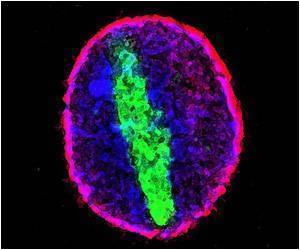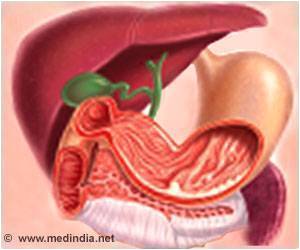- Alagille Syndrome - (http://www.niddk.nih.gov/health-information/health-topics/liver-disease/alagille-syndrome/pages/facts.aspx)
- About Alagille syndrome - (http://ghr.nlm.nih.gov/condition/alagille-syndrome)
- Bhatia V, Kumar P. Alagille syndrome with a previously undescribed mutation. Indian Pediatr. 2014;51(4):314-316.
- Information About Alagille Syndrome - (http://www.chop.edu/conditions-diseases/alagille-syndrome#.vwx4wuufufq)
- ALAGILLE SYNDROME 1; ALGS1 - (http://www.omim.org/entry/118450)
- Second Alagille Syndrome Gene discovered: More information on kidney disease - (http://www.bio-medicine.org/medicine-news/second-alagille-syndrome-gene-discovered-3a-more-information-on-kidney-disease-12834-1/)
- What is Alagille Syndrome ? - (http://www.ncbi.nlm.nih.gov/books/nbk1273/)
- Turnpenny PD, Ellard S. Alagille syndrome: pathogenesis, diagnosis and management. Eur J Human Genet. 2012;20: 251-257.
- Learn About Alagille Syndrome - (http://www.british-liver-trust.org.uk/liver/alagille-syndrome.html)
What is Alagille Syndrome (AGS)?
Alagille syndrome is a rare genetic condition that is observed in infants within the first 2 years of age. It affects around 1 out of 70,000 births. However, this statistic fails to take into account the number of children who have the disease but do not suffer from liver problems.
Alagille syndrome predominantly affects the liver. In addition, the heart and other parts of the body including the face, eyes and skeleton are also affected. The condition was reported by a hepatologist, Daniel Alagille in France in 1969. In 1973, Dr. Watson and Dr. Miller reported a similar case. This was followed by another case reported by Dr. Alagille in 1975, which then established the syndrome.
The mode of inheritance of Alagille syndrome is referred to as “autosomal dominant.” Each cell of our body contains 23 pairs of chromosomes called autosomes and one pair of sex chromosomes (2 X chromosomes in females, and one X and one Y chromosome in males). Autosomal disease indicates that the condition is passed from one generation to the next through an autosome and not the sex chromosomes. In a dominant form of inheritance, only one defective gene is sufficient to cause a disease; the defect need not be present on both the chromosomes of the pair.
In individuals with Alagille syndrome, there are fewer bile ducts in the liver. Bile ducts carry bile out of the liver and into the small intestine and the gall bladder. Bile is a liver secretion that helps in digesting fats and assists in eliminating waste material from the body. Thus, when the number of bile ducts is reduced, there is a buildup of bile in the liver, which results in a condition called cholestasis that damages the liver.
Problems in the heart are also observed in children with Alagille syndrome. Children may suffer from pulmonic stenosis, where blood flow from the heart to the lungs is impaired. Sometimes, along with pulmonic stenosis, there is a hole in the wall separating the 2 lower chambers of the heart (ventricular septal defect) or other abnormalities of the heart. Abnormalities in the eye, kidney, and the skeleton are other features of the syndrome. Kidney or renal abnormalities occur in 39% of the cases with Alagille syndrome. Pancreatic insufficiency is also observed in a few cases.
Some infants do not suffer from liver damage but only display characteristic facial features and aberrations in the functioning of the heart.
In India, Alagille syndrome is very rare and hence the prevalence of the condition is unknown.
Causes of Alagille Syndrome
So, what causes Alagille syndrome? Alagille syndrome is a genetic condition caused by a defect (mutation) in one of 2 genes, JAG-1 (Jagged-1) and NOTCH-2. The predominant mutation in most cases of Alagille syndrome is observed in the JAG-1 gene located on chromosome 20. Mutations in the NOTCH-2 gene are observed in fewer than 1% of the cases. The NOTCH-2 gene is located on chromosome 1. Both the causative genes were discovered at The Children’s Hospital of Philadelphia. Hereditary cases of Alagille syndrome are observed in 30% to 50% of the cases, while spontaneous mutations are observed in the remaining cases.
Symptoms and Signs of Alagille Syndrome
There are several signs and symptoms associated with Alagille syndrome depending on the organs involved:
Liver: The liver is the major organ that is affected in Alagille syndrome. Cholestasis or the buildup of bile is predominantly observed in the liver. In some cases, cholestasis is progressive, while in others there is no increase in cholestasis. Sometimes, liver cancer is also observed in some cases of Alagille syndrome. The effects of chronic cholestasis and reduced number of bile ducts are as follows:
White stools and dark urine: Due to the buildup of bile, the urine is dark in color. The bile is not transferred to the small intestine for digestion and hence, the stools become light in color and are white. These are warning signs observed after 2 weeks of age. The infant should be shown to the doctor in order to examine for liver damage.
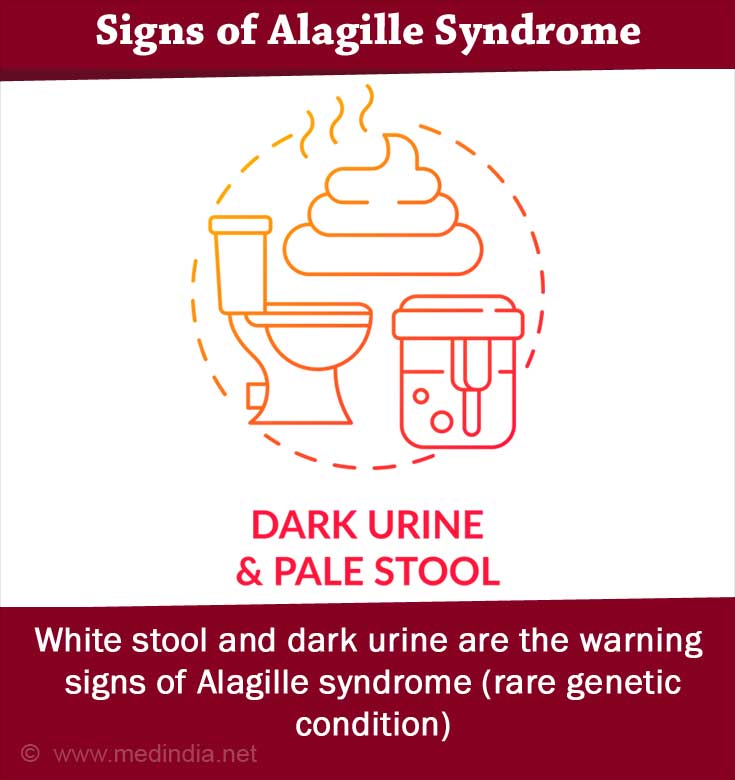
Xanthomas: These are deposits of fat on the skin. They are yellow in appearance and are observed in areas of the body, such as elbows, knees, tendons, buttocks, feet, and hands. They occur due to abnormal levels of cholesterol in the body.
Jaundice: There is yellowing of the whites of the eyes as well as the skin. Jaundice occurs because the liver does not remove the bilirubin formed from the breakdown of hemoglobin in the blood.
Pruritus: Itching due to bilirubin buildup is quite severe. It begins following 3 months of age.
Liver disease may also result in portal hypertension and cause enlargement of the spleen.
Skeletal bones: There are several abnormalities observed in the vertebrae and the bones of the fingers or toes. The spinal vertebrae commonly form the shape of flying butterflies. These butterfly vertebrae do not require treatment and do not cause complications.
Eyes: In individuals with Alagille syndrome, an opaque ring in the cornea of the eye is observed. This does not affect vision. This feature is called posterior embryotoxon. Pigmentary retinopathy, a condition that affects the innermost light-sensitive layer of the eye is another abnormality that may be present in the eye. Abnormalities in other parts of the eye may also be present.
Heart: Cardiac complications are commonly observed in individuals with Alagille syndrome. There may be problems with the heart valves, or the partitions between the cardiac chambers or the arteries, especially those supplying to the lungs.
Face: The facial features that characterize Alagille syndrome are a pointed nose, deep-set eyes, big ears, a particularly wide forehead, and a small, pointed chin.
Kidneys: Patients of Alagille syndrome may suffer from renal failure and obstruction to the flow of urine, and formation of cysts in the kidneys.
Cancer: This is observed in Alagille syndrome individuals ranging from 2 years to 48 years of age. Liver, thyroid, and lung cancer have been detected in patients with Alagille syndrome.
Brain: Bleeding within the brain is another symptom that is observed in patients with Alagille syndrome. This may occur due to abnormalities of blood vessels in the brain. Stroke can result from the narrowing of blood vessels in the head and neck.
Diagnosis and Treatment of Alagille Syndrome
Alagille syndrome is diagnosed with liver biopsy, genetic tests, cardiac exam, and urine analysis, among others. Liver transplant is the definitive way to treat liver damage.
Diagnosis of Alagille Syndrome
Alagille syndrome can be diagnosed with a physical examination and other tests, such as liver biopsy, x-ray, urinalysis, blood test, genetic tests, and ultrasound of the abdomen. A detailed cardiology exam and slit-lamp examination can identify cardiac and eye problems respectively.
Liver biopsy: A biopsy essentially means taking a small piece of tissue out for analysis. The patient is asked to stop taking any medications prior to the procedure. During the procedure, the patient lies on the table with the right hand below the head. A local anesthetic is applied on the area around the liver and pain medications are provided. A needle is guided by imaging techniques, such as computed tomography or ultrasound to extract a small piece of tissue for further analysis. The patient is advised to lie on the right side for 2 hours and then monitored for another 2 to 4 hours before being sent home.
Blood test: Blood drawn from the patient is sent for analysis in order to detect kidney and liver damage.
Genetic tests: A saliva sample or a blood sample may be acquired for genetic testing. It takes time to obtain the test results. Genetic testing analyzes the DNA in the saliva or blood sample to detect the JAG-1 gene or NOTCH2 gene. The JAG-1 gene is the most common gene that is affected in the Alagille syndrome.
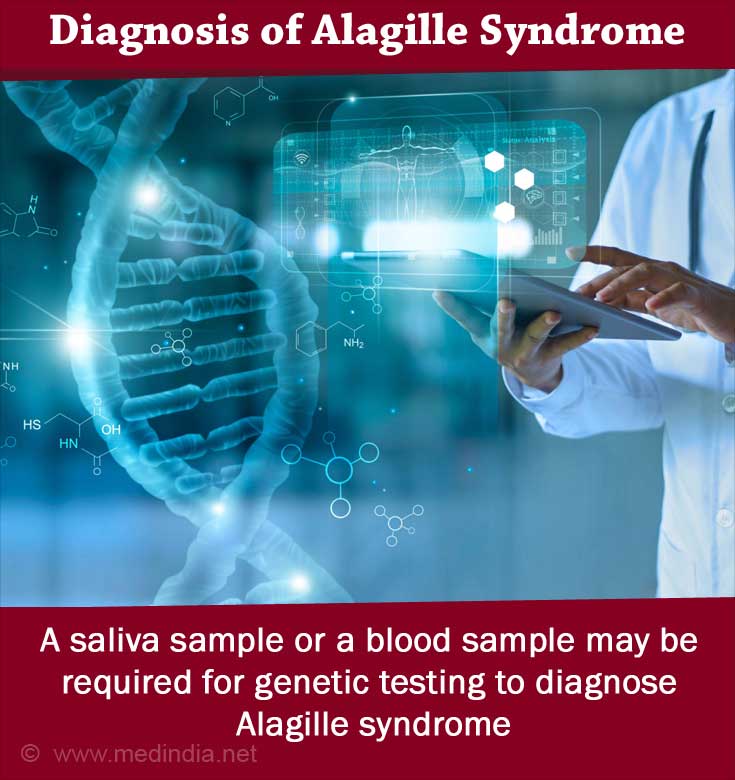
Slit-lamp exam: This is used to detect abnormalities within the eyes, especially posterior embryotoxon. The patient is made to rest the head on the slit lamp, where a light shines into the eye to analyze the cornea. A yellow dye is applied to the eye by touching the surface with a piece of special paper or with drops. Additional drops to dilate the pupil are also be used to check the inner layer or the retina.
X-ray: X-rays are used to detect bony abnormalities like butterfly vertebrae, which may support the diagnosis.
Urinalysis: A urine examination will reveal features of liver disease.
Abdominal ultrasound: An ultrasound is used to transmit sound waves to the internal organs with the help of a transducer that can be handheld. These sound waves bounce back when they hit an organ and give a pattern that represents the internal organ. Thus, abnormalities in the liver and kidney can be detected through abdominal ultrasound.
Cardiac tests: Cardiac tests like ECG and echocardiography can be used to diagnose structural cardiac problems.
Treatment for Alagille Syndrome
Based on the diagnosis, the mode of treatment is decided. Biliary diversion is a useful treatment for those with liver damage, pruritus, and xanthomas. Liver transplantation is another form of treating damaged livers. The transplantation is successful if there is no coexisting kidney or heart damage. The degree of severity of damage to these organs may hamper the effectiveness of the liver transplant. The liver performs well in most cases after the transplant. In the case of a transplant from a relative, genetic testing should confirm that the relative also does not have no mutation in the genes that cause Alagille syndrome.
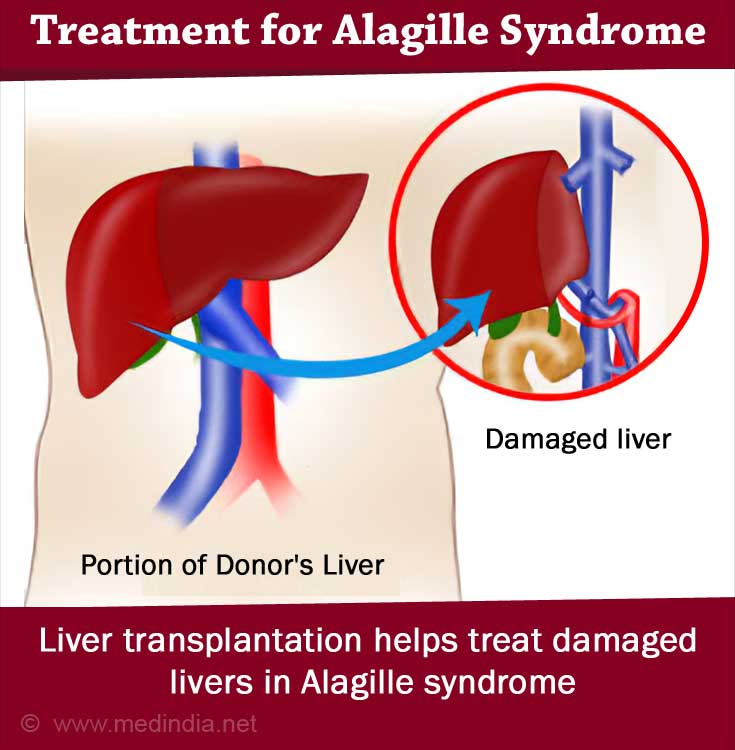
In children, pruritus or itching is severe when there is liver damage. Pruritus can be treated with medications like ursodeoxycholic acid, naltrexone, cholestyramine, or rifampin.
Growth issues due to insufficient absorption of nutrients can be treated by improving the nutritional intake in children. Infants are given a special formula that allows the small intestine to absorb sufficient amount of fat. A diet rich in vitamins A, D, K, E, calcium and fats is recommended to infants, children, and adults. A feeding tube may be necessary in those who cannot take it orally. Instead of vitamin capsules, patients who are unable to deal with oral doses can get injections of vitamins from their family physician.
Kidney and cardiac problems are treated based on the condition affecting the organs. Vertebral anomalies and eye abnormalities do not often require medical intervention. Head injuries and other neurological problems are treated immediately and aggressively.
Prevention of Alagille Syndrome
Alagille syndrome is a genetic disorder and hence cannot be prevented unless genetic counseling and gene testing are performed before conceiving a child. The parents are given the odds of obtaining a child with the condition. Once the child is born, the best procedure is to properly manage the condition with regular screenings of all organs that can get affected, i.e., liver, heart, kidneys, eyes, blood vessels, and brain.
Careful attention should be given to the nutrition of individuals with Alagille syndrome since growth is affected in this condition.
Children with Alagille syndrome should be monitored regularly for their vitamin concentrations in the plasma and should be supplemented with vitamins, when necessary, in order to prevent any delay in development.
Health Tips
Individuals should avoid consuming alcohol if there are problems in the functioning of the liver. Contact sports should be avoided if there is an enlarged spleen (splenomegaly) or other disease conditions of the liver.
Children with Alagille syndrome often suffer from poor sleep due to pruritus. Treating pruritus with medications is a good way to manage the condition and obtain good sleep.


